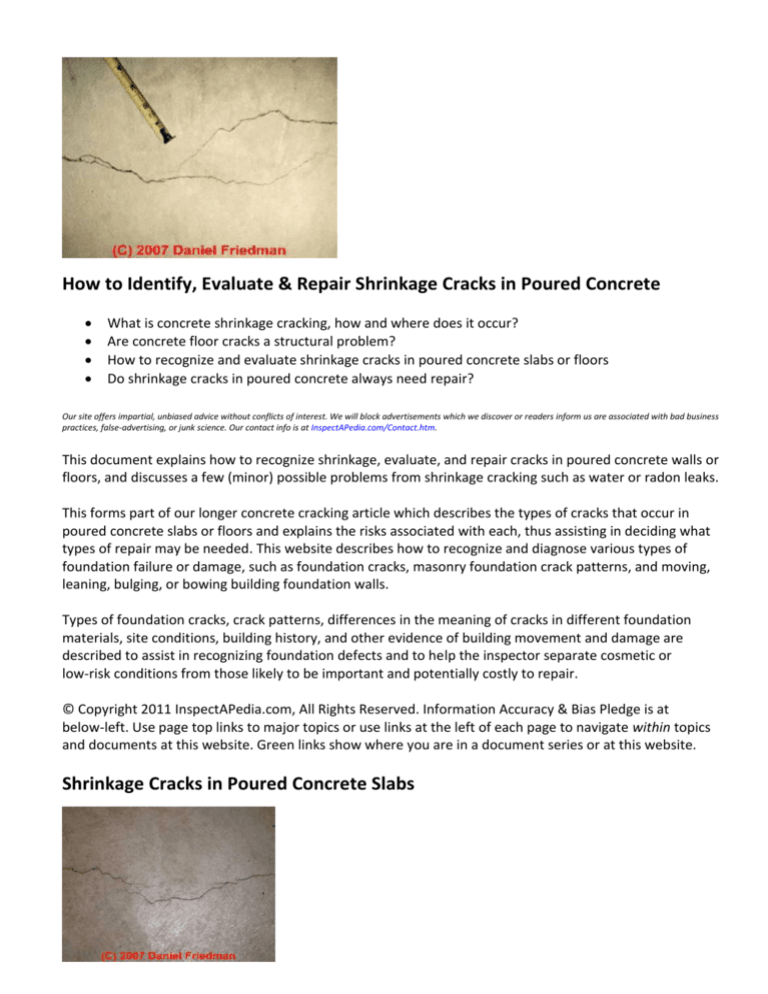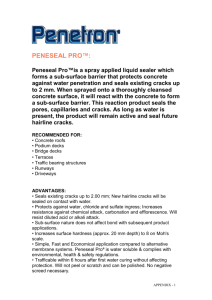
How to Identify, Evaluate & Repair Shrinkage Cracks in Poured Concrete
What is concrete shrinkage cracking, how and where does it occur?
Are concrete floor cracks a structural problem?
How to recognize and evaluate shrinkage cracks in poured concrete slabs or floors
Do shrinkage cracks in poured concrete always need repair?
Our site offers impartial, unbiased advice without conflicts of interest. We will block advertisements which we discover or readers inform us are associated with bad business
practices, false-advertising, or junk science. Our contact info is at InspectAPedia.com/Contact.htm.
This document explains how to recognize shrinkage, evaluate, and repair cracks in poured concrete walls or
floors, and discusses a few (minor) possible problems from shrinkage cracking such as water or radon leaks.
This forms part of our longer concrete cracking article which describes the types of cracks that occur in
poured concrete slabs or floors and explains the risks associated with each, thus assisting in deciding what
types of repair may be needed. This website describes how to recognize and diagnose various types of
foundation failure or damage, such as foundation cracks, masonry foundation crack patterns, and moving,
leaning, bulging, or bowing building foundation walls.
Types of foundation cracks, crack patterns, differences in the meaning of cracks in different foundation
materials, site conditions, building history, and other evidence of building movement and damage are
described to assist in recognizing foundation defects and to help the inspector separate cosmetic or
low-risk conditions from those likely to be important and potentially costly to repair.
© Copyright 2011 InspectAPedia.com, All Rights Reserved. Information Accuracy & Bias Pledge is at
below-left. Use page top links to major topics or use links at the left of each page to navigate within topics
and documents at this website. Green links show where you are in a document series or at this website.
Shrinkage Cracks in Poured Concrete Slabs
Shrinkage cracks in poured concrete are easily recognizable and can be distinguished from other types of
cracks that occur later in the life of a foundation wall or floor slab.
The photograph of cracks above was taken of shrinkage cracks in a concrete slab floor in a home built in
2006. The cracks in this case ranged in width (measured across the crack) from "hairline" (less than 1/16")
to about 3/32" in the basement floor slab of this particular home. They may appear larger.
What is unique about shrinkage cracks in concrete is that they usually appear to be discontinuous, as shown
in this photo. The crack will meander along in the concrete, taper to a stop, and then continue beginning in
a parallel line to the first crack, meandering again through the concrete.
This is characteristic of concrete (or mud) shrinking while giving up its moisture.
You can see the shrinkage of even a perfect concrete floor slab with no visible cracks in the field of its surface if
the floor was poured inside of an existing foundation. Look for the gap between the edges of the slab and the
foundation wall? Look also for the stains or concrete debris on the wall at the slab level? These confirm that at
the time the slab was poured it was touching the wall.
Causes of variation in width of shrinkage cracks in poured concrete
Why do concrete shrinkage cracks vary in width across a wall or floor? Probably because concrete shrinkage
cracks are meandering or "wandering" in their path, and are usually intermittent or interrupted in their
course, as you can see in the photograph above.
As the path of cracking caused by concrete shrinkage wanders and stops and starts across an area of wall or
floor, you will often see overlapping or roughly parallel nearby cracks that represent the end of one crack
line and the beginning of another. The total width of the two close-by cracks is probably about the same as
the total crack width where a crack wanders in solitary along the concrete. The stresses producing the crack
have simply shifted slightly in the wall or floor as it cured.
Why cracks appear to originate in poured concrete walls at windows or at
outside corners in concrete floor slabs
Why do concrete shrinkage cracks often begin near the corner of a window, or in a floor near a corner in
the foundation footprint?
If you think of the entire reinforced concrete wall or floor as a rather uniform membrane, any discontinuity
in the membrane, such as an opening for a window or the placement of a corner projecting into the room in
the case of a floor, creates a variation in the distribution of (shrinkage during curing) forces in the wall or
floor.
Shrinkage cracks may have their origin at these points of discontinuity.
What is the significance of differences in concrete height on opposite sides of a
crack?
Why are some "shrinkage cracks" at different heights on either side of the crack? The floor on one side of
this 3/16" wide crack was about 3/32" higher than on the other. This may be due to settlement of the
broken slab section on poorly-compacted fill in the building's basement.
Multiple forces and movements may be present as a poured concrete foundation cures, such as a
combination of shrinkage and settlement, or shrinkage and outside pressures on a wall from backfill. (It's
best to let any masonry wall cure before backfilling, though that's most critical with masonry block (CMU)
walls where early backfill before the first floor has been framed in place has been known to lead to a total
collapse of the foundation.)
In a poured concrete wall or floor if the surface of the concrete on opposite sides of a crack are also at
different elevations, that is if the concrete on one side of a crack is higher than the other, additional forces
have been at work and the crack is not a simple shrinkage crack.
Repair cracks that make trip hazards: If the height difference across a floor crack is 1/8" or more it forms a
tripping hazard and it should be repaired.
Do we need to repair shrinkage cracks in foundation walls or slabs?
Small shrinkage cracks that are above ground level in a foundation wall, such as the cracks in the inside
corner of this poured concrete foundation are unlikely to be much of a problem except for a few less
common cases where water running down the wall is leaking in at the shrinkage crack.
[Do you think that the crack shown here is an initial footing or foundation settlement crack? Maybe so.]
Shrinkage cracks in concrete walls or floor slabs that are leaking into the building interior such as the one
shown in this photograph should be sealed.
However a careful inspection in this particular case revealed that the window flashing and exterior siding
had been installed so as to direct wind-blown rain into a concentrated runoff pattern that [unfortunately]
passed over and then through this crack in the foundation wall. Some flashing and siding adjustments
outside cured this problem.
Concrete cracks often occur at natural stress points where the uniformity of a poured concrete wall or
floor has been interrupted by placement of a window (in walls of course) or inside corners (in floors). You
may often find shrinkage cracks that trace across the concrete to these stress points.
Shrinkage cracks in a concrete slab or floor might need to be repaired to avoid water leakage from below
or to stop radon gas entering the building. In the photograph shown here the floor was badly cracked from
a combination of concrete shrinkage, settlement, and frost heaves (the building had been left un-heated in
a freezing climate).
You can see that lots of water was leaking into the basement up through the floor. In this case, while
repairs to the basement floor, or perhaps better, a new basement floor slab, were in order, the root cause
of high water levels under the basement floor needed to be addressed first.
How are concrete walls, foundation, or floor slab shrinkage cracks avoided or
repaired
While shrinkage in poured concrete walls or floor slabs is a normal property of curing concrete, shrinkage
cracks can be controlled, or where they have occurred, in some cases repairs are needed. In addition to
reading about repairing concrete shrinkage cracks (if crack repair is needed at all) at Shrinkage Crack
Repairs also see how we prevent shrinkage cracks in poured concrete floors and walls by reading Cracks at
Control Joints in Concrete.









